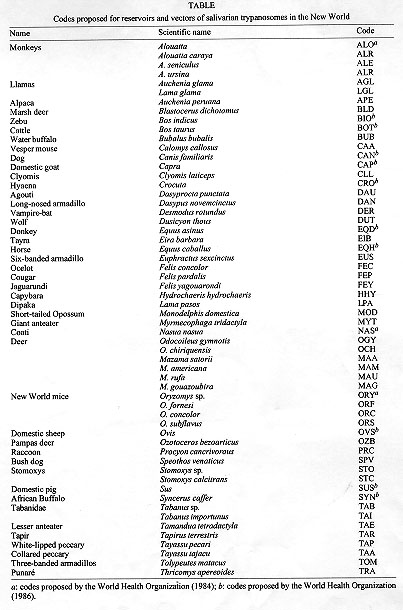Trypanosoma evansi; Trypanosoma vivax; salivaria; codes; identification; hosts; vectors
RESEARCH NOTE
Codes for Labelling Salivarian Trypanosomes in the New World
Vol. 93(3): 301
AMR Dávila+, L Ramirez, RAMS Silva
Laboratório de Sanidade Animal, Centro de Pesquisa Agropecuária do Pantanal, Embrapa, Rua 21 de Setembro 1880, 79320-900 Corumbá, MS, Brasil
Key words: Trypanosoma evansi - Trypanosoma vivax - salivaria - codes - identification - hosts - vectors
RESEARCH NOTE
Codes for the designation of trypanosome isolates/stocks are necessary for the correct identification and manipulation of parasites. The documentation of these parasites is very useful since, using incorrect documentation, two or more researchers could be working with the same sample but with different designations. In addition, the correct designation can facilitate sample exchanges.
Based on terminology, maintenance, documentation and parasite designation for Trypanosoma brucei of the World Health Organization (WHO 1986 Epidemiology and Control of African Trypanosomiasis, 127 pp.), we suggest a number of codes for labelling salivarian trypanosomes in the New World. Reports and reviews on reservoirs and vectors of salivarian trypanosomes in the New World (CA Hoare 1972 The Trypanosomes of Mammals. A Zoological Monograph, Blackwell Scientific Publications, Oxford, 749 pp., PR Gardiner & MM Mahmoud 1992 Salivarian trypanosomes causing diseases in livestock outside Sub-Saharan Africa, p. 277-314. In JP Kreier & JR Baker (eds), Parasitic Protozoa, Academic Press, USA, DH Ferris 1984 Trop Vet Med News 2: 1-37, L Touratier 1992 Ver Sci Tech Off Int Epiz 11: 285-294, M Desquesnes 1996 Trypnews 3: 1-2) served as the basis for this proposal. The codes suggested for reservoirs and vectors of salivarian trypanosomes in the New World are given in Table.
Many vectors and hosts of salivarian trypanosomes in the New World are not included in the recommendations of the WHO (loc. cit.) but can be found in the document for labelling Leishmania (WHO 1984 Technical Report Series No. 701 and 1990 No. 793). However, the codes proposed in the present work can be used for labelling salivarian trypanosomes using the methodology described by the WHO (loc. cit.). For example, the T. evansi stock maintained in Embrapa/CPAP and designated as ETRG (Embrapa Trypanosomaiasis Research Group) NN5 would have the following code: MNAS/BR/96/ETRG-NN5, where M identifies the type of host animal or vector from which the sample was isolated (e.g. M for mammalia and I for insect). NAS is the generic code of the coati (Nasua nasua). BR is the country of isolation and should be given in accordance with the international code of vehicle registration such as proposed by the WHO (loc. cit.) (e.g. AR: Argentina; BO: Bolivia; BR: Brazil; CL: Chile; CO: Colombia; EC: Equador; GF: French Guyana; GY: Guyana; PE: Peru; SR: Suriname; VE: Venezuela; etc.) The number 96 is the year of isolation and ETRG-NN5 is the laboratory designation (e.g., laboratory code and serial number).
The designation of derived populations, VATs and VAT repertoires would be used as recommended by the WHO (loc. cit.).
We believe that the nomenclature and codes proposed in this work can be useful to facilitate sample exchanges and to avoid the use of two or more names on the same sample. Also, these codes are very useful referring to species because intraspecific variations may be found among isolates from different hosts or vectors belonging to the same trypanosome species. We have incorporated some codes from WHO´s Leishmania and Trypanosoma (WHO 1984, 1986, 1990 loc. cit.) host codes in an effort to avoid duplication and ambiguities.
+Corresponding author. Fax: +55-67-231.1011. E-mail: amrdavila@hotmail.com
Received 25 April 1997
Accepted 18 March 1998
Publication Dates
-
Publication in this collection
08 Oct 1998 -
Date of issue
May 1998
History
-
Accepted
18 Mar 1998 -
Received
25 Apr 1997


